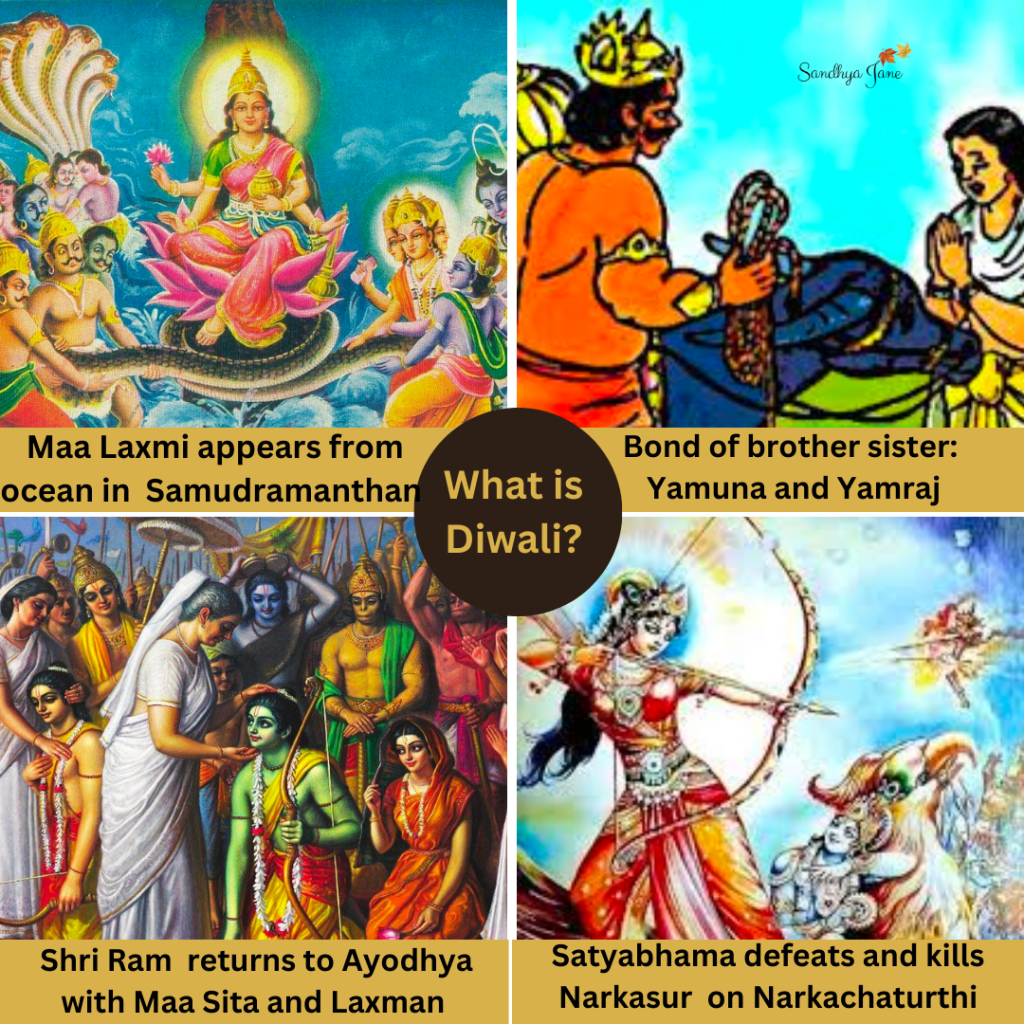Diwali is NOT a festival of lights, friends.
Diwali or Deepavali is a major Sanatan (Hindu) festival that originated from three yugs, Satyugs, Tretayugs, and Dwaparyugs.
Satyug: At the beginning of Satyug, Maa Laxmi appeared from the Ocean during Samudramanthan on Laxmi Puja day. It is her birth anniversary and we worship Maa Laxmi to seek her blessings.
Along with Maa Laxmi, we also worship Ganesh Ji, her adopted son. Ganesh Ji, who is the god of knowledge, finds worthy persons and distributes Maa Laxmi’s wealth among devotees. We worship Ganesh Ji and seek his blessings in our future endeavors.
Bhaiduj celebrations also originated in Satyug. On this day, the sister applies tilak to her brother and prays to Yamraj with folded hands for his long life. Skandpuran says that by pleasing Yamraj on this day, worshipers get their wishes fulfilled. Till this day, brother and sister bonds are celebrated. Even a married daughter visits her parents’ home after celebrating the First part of Diwali at husband’s home and enjoys the remaining part of the Diwali festival at her parent’s home.
Tretayug: In Tretayug, on Diwali, Shri Ram returned to Ayodhya after defeating Lankeshwar Ravan in Lanka. His victory represents standing up to Adram and restoring society’s peace. He also fought to bring back Ayodhya’s Kulvadhu Maa Sita and restore her honor. Ayodhyawasi (residents of Ayodhya) welcomed Shri Ram Ji, Maa Sita and Shri Laxman by lighting thousands of lamps.
We worship Shri Ram to remind us to follow him on the path of Dharma.
Dwaparyug: In Dwaparyug, on Narak Chaturthi, Satyabhama (Sri Krishna’s wife) defeats and eventually destroys demon Narkasur. Narkasur was the son of Bhoodevi or Mother Earth Bhagwan Varaha. He had a boon and special power
“I have no doubt he will become the most powerful warrior in the three worlds,” said Bhoodevi admiring her son.
“Powerful, he will certainly be,” said Lord Varaha. “Will he also uphold the dharma? What makes an individual remarkable is his adherence to the dharma.” His fear came true as Narakasur became the biggest aasur (demon) as he misused the boons and abducted 16,000 women from Dwarka.
On the dark night of Chaturdashi, the fourteenth day of the new moon fortnight, Naraka took out Lord Varaaha’s deadly tusk and threw it at Krishna. Struck in the chest Krishna fell unconscious. Even as Naraka cried victory, Sathyabhama picked up the bow and continued the fight. In Satyabhama, Naraka found a worthy foe. He had no clue how to stop her onslaught and was killed by Satyabhama.
In that time, there was no concept of gender equality and no one made a big deal of Satyabhama for killing a demon.
The firecracker burning ritual is part of Diwali celebrations for ages. It is meant for practical purposes considering Indian hot and humid weather where mosquitoes and insects breed after the monsoon season. Sulfur in crackers kills mosquitoes and insects, reducing disease outbreak chances and keeping society safe.
Every festival reminds us to pray to deities, uphold Santan Dharm, adapt Bhagwan’s qualities, and enjoy the opportunity to socialize and feast. A nice break from mundane life.
These festivals are so beautifully woven that they rejuvenate our mind, body, and spirit.
— Sandhya Jane

